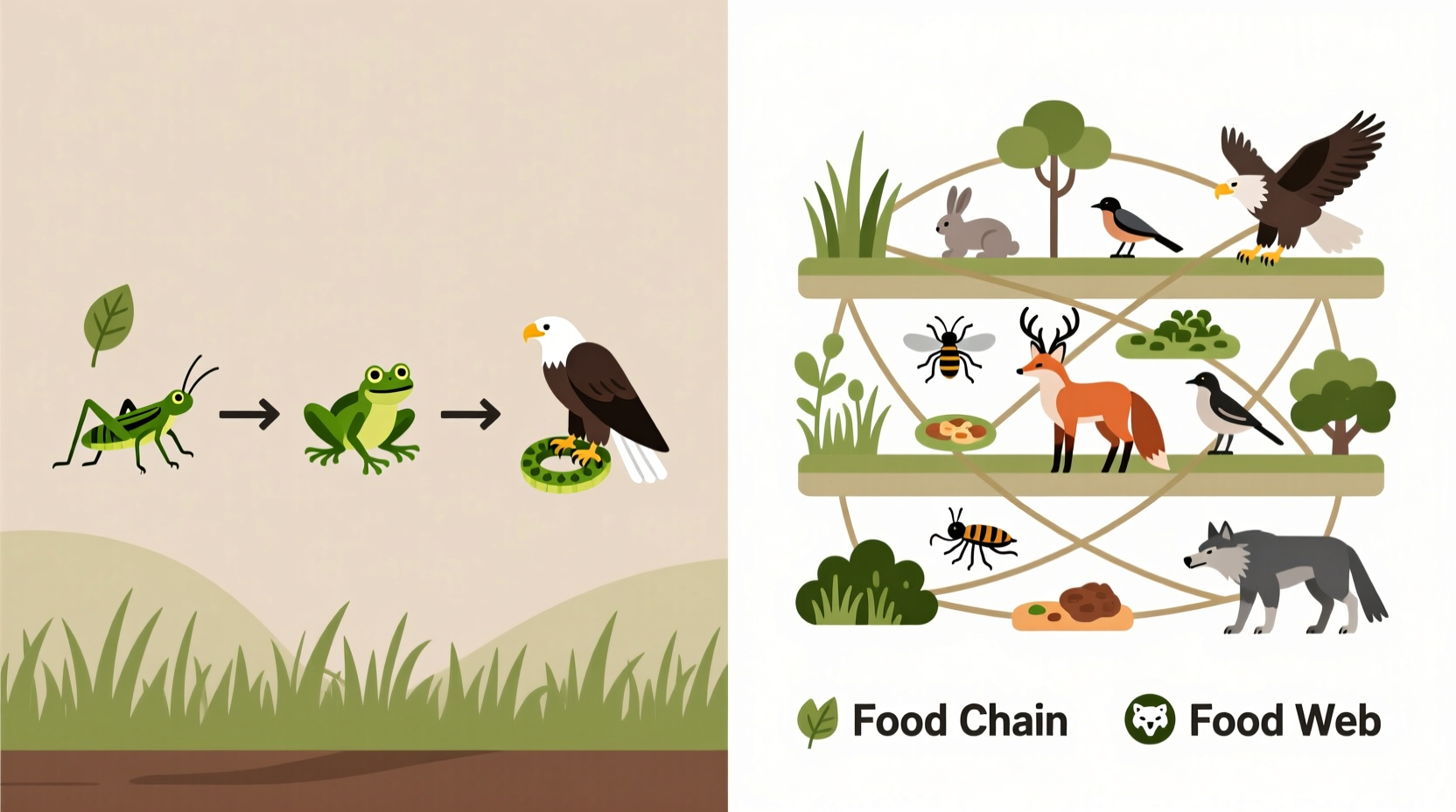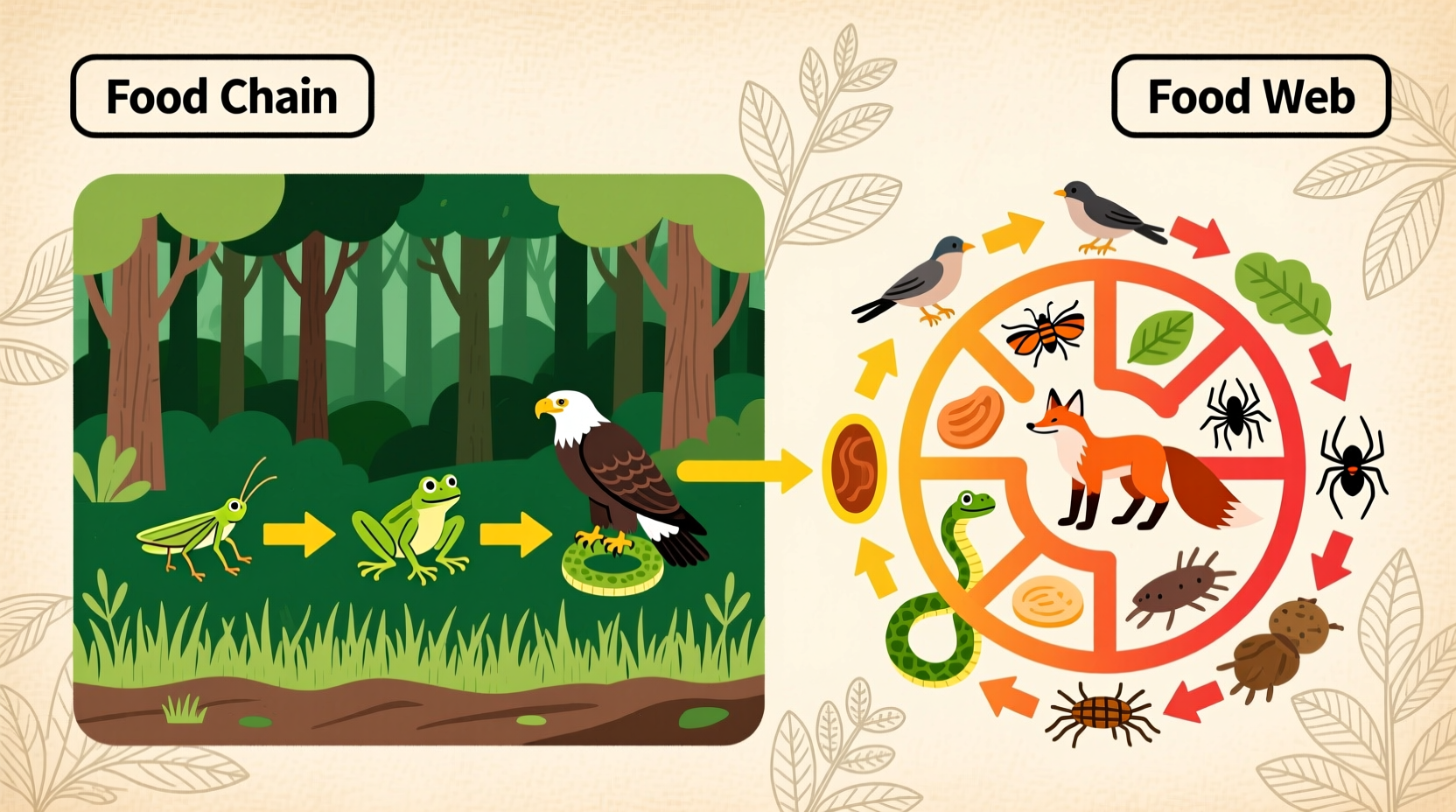Understanding Ecosystem Energy Flow: Food Chains vs. Food Webs
When studying ecology, grasping the distinction between food chains and food webs is fundamental to understanding how energy moves through ecosystems. In this article, you'll learn exactly how these two ecological models differ, why both are valuable tools for scientists, and how to visualize these concepts with real-world examples you can apply immediately.
What Every Student Needs to Know First
Before diving deeper, let's clarify the core concepts. A food chain follows one straightforward path of who eats whom in an ecosystem. Think of it as a single thread in nature's tapestry. In contrast, a food web weaves together multiple food chains into an interconnected network, revealing the true complexity of feeding relationships.
While food chains provide simplified models that help beginners understand energy transfer, food webs offer a more realistic representation of how most ecosystems actually function. This distinction isn't just academic—it affects how ecologists predict ecosystem responses to environmental changes.
Breaking Down the Key Differences
Understanding these concepts requires examining their structural and functional differences. Let's explore what makes each model unique and when scientists prefer one over the other.
| Feature | Food Chain | Food Web |
|---|---|---|
| Structure | Linear sequence (single pathway) | Interconnected network (multiple pathways) |
| Complexity | Simple, easy to follow | Complex, shows multiple relationships |
| Realism | Oversimplified representation | More accurate ecosystem model |
| Stability Analysis | Shows vulnerability to disruptions | Demonstrates ecosystem resilience |
| Example Scope | Follows one energy path | Tracks multiple energy pathways simultaneously |
Real-World Examples That Make the Difference Clear
Consider a simple grassland ecosystem. A food chain might show: grass → grasshopper → frog → snake → hawk. This linear progression illustrates energy moving up trophic levels, but it misses crucial connections.
Now imagine the same ecosystem as a food web. The grasshopper doesn't just eat grass—it might consume multiple plant species. The frog doesn't only eat grasshoppers but also worms and flies. The snake might eat frogs, mice, and lizards. This interconnected network reveals how energy flows through multiple pathways, creating redundancy that helps ecosystems withstand disturbances.
According to research from the National Geographic Society, ecosystems with complex food webs demonstrate greater resilience when facing environmental changes. When one species declines, organisms can often switch to alternative food sources, preventing ecosystem collapse.

Why Understanding This Distinction Matters
These models aren't just classroom concepts—they have real-world applications. Conservation biologists use food web analysis to predict how removing a species might impact an entire ecosystem. When wolves were reintroduced to Yellowstone National Park, scientists tracked changes through the food web, observing ripple effects that transformed the entire landscape.
Food chains help identify critical vulnerabilities. If a disease wipes out grasshoppers in our simple chain, frogs lose their food source, followed by snakes and hawks. But in a food web, frogs might switch to eating more worms, buffering the ecosystem against collapse.
Environmental educators emphasize that while food chains provide an accessible entry point, food webs better represent nature's complexity. As noted by the Encyclopædia Britannica, "Most food chains are part of a more complex network of energy pathways called a food web."
Common Misconceptions to Avoid
Many students mistakenly believe food chains and food webs are competing models. In reality, food chains are components of food webs—each linear pathway exists within the larger network. Another misconception is that food webs are simply "longer" food chains. The critical difference lies in the multiple interconnected pathways, not length.
Remember that both models simplify reality. Even the most detailed food web can't capture every feeding relationship, but they provide valuable frameworks for understanding ecosystem dynamics.
Practical Applications for Students and Educators
When creating your own ecological models, start with simple food chains to establish basic relationships, then expand into food webs to show complexity. Field biologists often begin with food chain observations before developing comprehensive food web diagrams.
For classroom activities, have students build food chains from local ecosystems, then challenge them to connect multiple chains into a food web. This progression helps learners appreciate both the simplicity of linear models and the realism of interconnected networks.
Key Takeaways for Understanding Ecosystem Dynamics
Food chains provide essential building blocks for ecological understanding, while food webs reveal the intricate relationships that maintain ecosystem stability. Recognizing how energy flows through single pathways versus interconnected networks helps explain why biodiversity matters and how ecosystems respond to environmental changes.
Whether you're studying for an exam or designing conservation strategies, understanding both models—and their differences—gives you powerful tools for analyzing ecological relationships. The next time you observe nature, try identifying both simple food chains and the larger food web connecting them.











 浙公网安备
33010002000092号
浙公网安备
33010002000092号 浙B2-20120091-4
浙B2-20120091-4